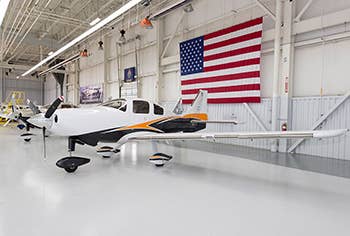
It's been a long time coming, but Cessna's speediest single-engine piston airplane, the all-composite, high performance TTx, which was developed out of the Columbia 400, has achieved a sign-off from the FAA that allows its pilots to fly in known icing conditions. The approval for flight into known icing, or FIKI for short, was achieved with the TKS weeping wing system, which provides up to 2.5 hours of anti-ice protection, Textron Aviation said.
The TKS system prevents and removes ice through the application of a glycol-based fluid that is sprayed through micro-sized holes in the titanium-covered leading edges of the wings. When in use, the system also sprays the solution on the prop and windshield.
The TKS system will be available as an option for the TTx for an additional $52,000. Textron aviation said there is no change in the performance with the additional equipment. The weight penalty is minimal, with only 45.6 pounds added for the equipment and a total of 137 pounds with the fluid container filled. The system had already received a supplemental type certificate for the previous models of the TTx — the Cessna 350 and 400.
Kelly Aerospace is also offering an aftermarket anti-ice option for the TTx, which prevents ice build through a heated graphite foil surface. Walter Dodge from Kelly Aerospace said the TTx required no modifications of its ThermaWing system, which is STC'd for the previous Cessna 350 and 400 models, and the paperwork for the STC is in process with the FAA.
While the STC'd systems provide ice protection, they do not allow the pilot to fly into areas of known icing.
Get exclusive online content like this delivered straight to your inbox by signing up for our free enewsletter.
We welcome your comments on flyingmag.com. In order to maintain a respectful environment, we ask that all comments be on-topic, respectful and spam-free. All comments made here are public and may be republished by Flying.

Sign-up for newsletters & special offers!
Get the latest FLYING stories & special offers delivered directly to your inbox






